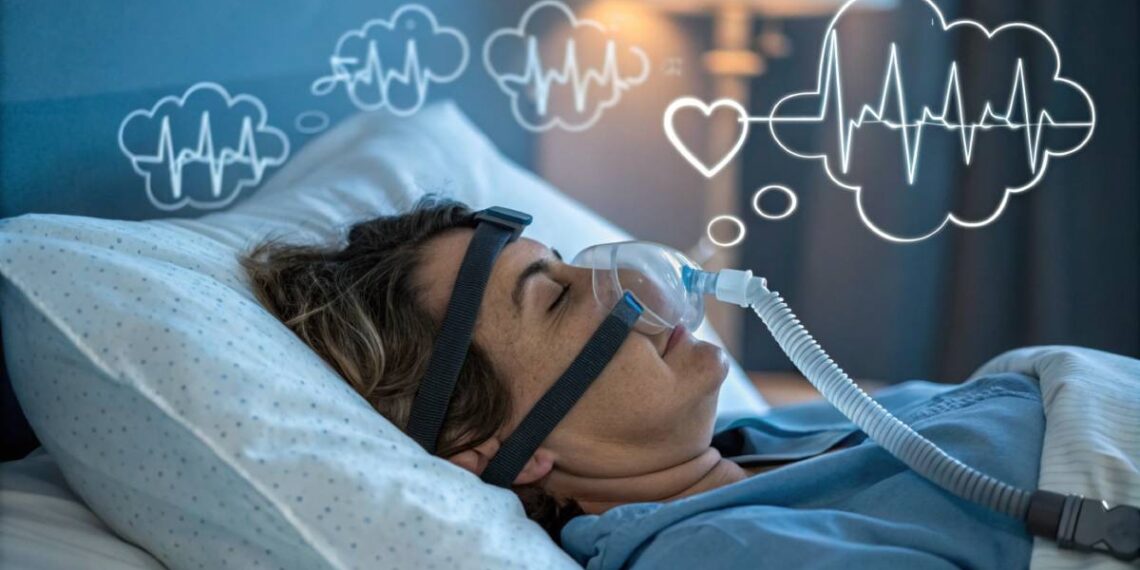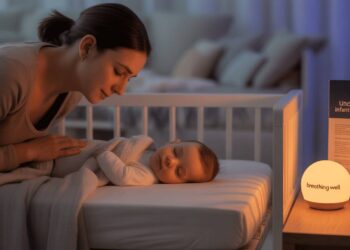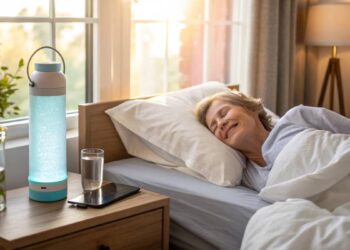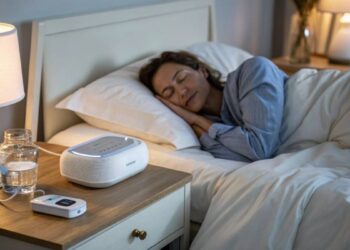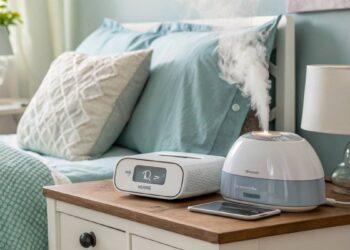Struggling to catch your breath in the middle of the night? You’re not alone. Sleep apnea is a hidden disruptor affecting millions, silently sabotaging restful sleep and daily well-being. From loud, persistent snoring to unexpected daytime fatigue, recognizing the key symptoms is crucial for reclaiming your nights and enhancing your health. Dive into our comprehensive guide to unmask the subtle signs of sleep apnea, understand its profound impacts, and discover actionable steps to breathe easier and live better. Your journey to uninterrupted sleep starts here!
Key Takeaways
- Understanding Sleep Apnea: Differentiates between obstructive and central sleep apnea.
- Impact of Untreated Sleep Apnea: Links untreated sleep apnea to cardiovascular issues, mental health struggles, and safety hazards.
- Common Symptoms: Highlights loud snoring, pauses in breathing, and excessive daytime sleepiness as primary indicators.
- High-Risk Groups: Identifies overweight individuals, those over 40, partners of heavy snorers, and commercial drivers as high-risk categories.
- Challenges and Considerations: Discusses resistance to CPAP therapy and concerns about pediatric sleep apnea.
Understanding Sleep Apnea
What is Sleep Apnea?
Sleep apnea ain’t just a fancy term to throw around. It’s a sneaky condition where your breath decides to take a break while you’re dozing. Imagine drifting off into dreamland only to have your breathing hit pause – not fun! The hiccups in breathing last from a blink to nearly a minute, happening multiple times through the night. The show’s star is obstructive sleep apnea, where throat muscles get a little too comfy, blocking airways. Then there’s the lesser-known cousin, central sleep apnea, where the brain forgets to drop the memo to breathe. Spotting the signs early is a good move to tackle this beast head-on.
| Type of Sleep Apnea | Description |
|---|---|
| Obstructive Sleep Apnea | When lazy throat muscles decide to interrupt your air supply. |
| Central Sleep Apnea | When your brain forgets to tell you to breathe. |
Curious for more? Check out our dive into central vs obstructive sleep apnea for all the nitty-gritty.
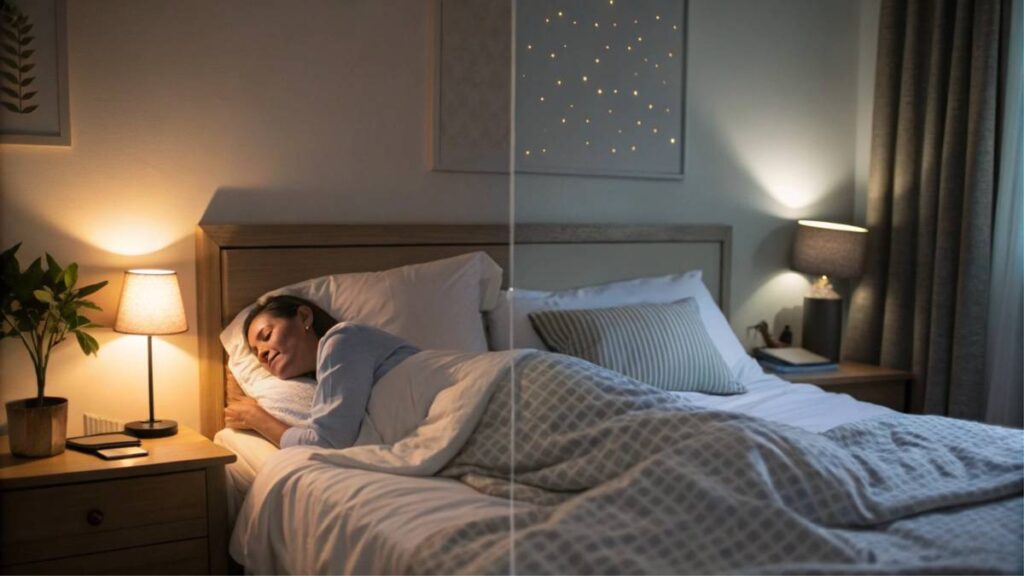
Impact of Untreated Sleep Apnea
Playing the ignore card with sleep apnea can throw a wrench into your whole system. It ushers in a parade of troubles nobody signed up for. Here’s what you might be staring down:
- A spike in heart troubles like high blood pressure and heart disease. Who wants that drama?
- The blues might hit hard, with depression or anxiety tagging along.
- Memory glitches and decision-making blips become the norm, thanks to brain fog.
- Daytime fatigue cranks up the odds of mishaps, a serious buzzkill for road warriors like truckers.
| Health Issues | Potential Risks |
|---|---|
| Cardiovascular problems | High blood pressure, heart woes |
| Mental health struggles | Depression, anxiety |
| Brain funk | Forgetfulness, focus issues |
| Safety hazards | More accidents from nodding off |
If you’re itching to learn about sleep apnea’s love affair with heart health, our sleep apnea heart problems piece is a must-read.
Sleep apnea is not just about snoring; it’s a serious medical condition that affects the quality of your sleep and your overall health.” – Dr. Jane Smith, Sleep Specialist
Jumping on sleep apnea symptoms pronto can dial down these headaches, keep you healthier, and make every day feel a little brighter. Folks with family, partners, or jobs that keep ’em on their toes should stay sharp and maybe consider a home sleep apnea test to get ahead of the game.
Common Sleep Apnea Symptoms
Sleep apnea likes to crash in on your peace without an invite, showing off a mixed bag of signs that can make life tricky. Knowing these sneaky symptoms is like having a flashlight in the dark – they help you spot the problem and call for backup. Let’s check out some tell-tale signs that could mean sleep apnea is knocking at your door.
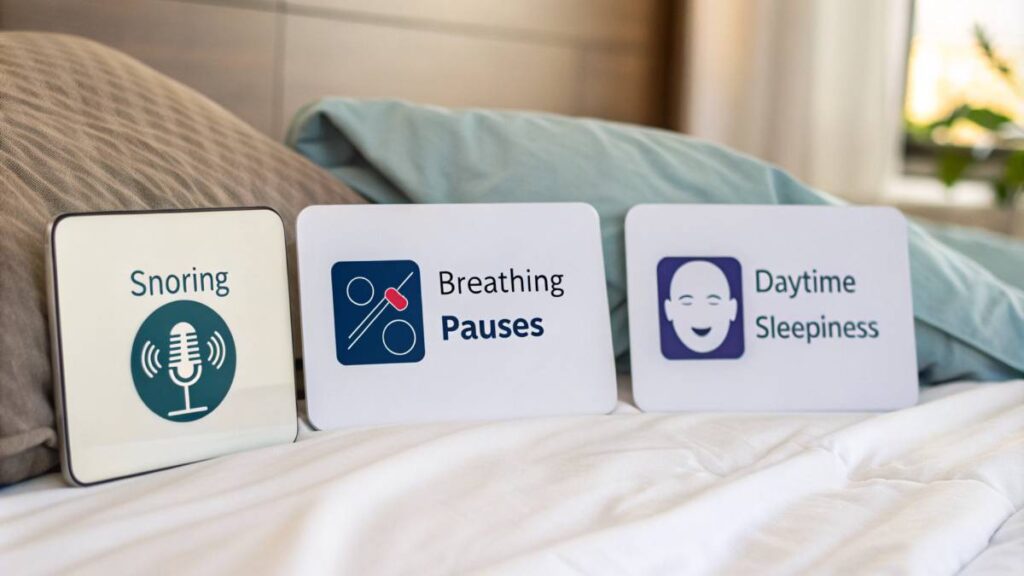
Loud and Persistent Snoring
If you’ve got a snorer in the house, you know it’s like having a freight train rumbling next to you. Unchecked snoring could be a big hint of sleep apnea, especially when it shakes the roof and rouses everyone from their slumber. This kind of snoring can start soft then suddenly crank up the volume, sometimes thrown out of sync by sounds of choking or gasping for air. And if you’re rolling solo at night, figuring this out can be like trying to catch smoke with your hands.
| Snoring Type | Description |
|---|---|
| Loud Snoring | Noise levels that are next-level, waking others or sounding from down the hall. |
| Intermittent Snoring | On-again, off-again snoring, matching pauses when the breather gets stuck. |
| Gasping or Choking | Snoring cut short by breathless gasps as if coming up for air. |
Pauses in Breathing
People playing the sleep apnea game also juggle breathing stutters in their sleep. These pauses can range from several beats to the length of a song, happening again and again all night long. You might not notice them just snoozing by yourself, but they lead to less air hitting the bloodstream and a night of broken dreams. If your sleep buddy gives you a nudge or a push because you’ve gone quiet, that’s a red flag waving in the dark.
Studies have given us a bit of a manual on how these breaks work:
| Breathing Pauses | Average Duration | Frequency Per Night |
|---|---|---|
| Short | 10-20 seconds | 20-30 pauses |
| Long | 30 seconds or more | Over 30 pauses |
Excessive Daytime Sleepiness
If your pillow-time leaves you running on empty by daybreak, daytime drowsiness might be pointing fingers at sleep apnea. Even after clocking a whole night in your bed, feeling like a zombie means something’s fishy. This worn-out feeling puts a damper on life – from your morning cup to your work grind. Those brain zaps when trying to rest up are like an evil prankster keeping you yawning all day.
| Daytime Sleepiness Level | Description |
|---|---|
| Frequent Naps | Uncontrollable urge to steal some zzzs with mini rest breaks. |
| Difficulty Concentrating | Can’t seem to lock your brain on work or play. |
| Mood Changes | Grumpy cat mode activated, no thanks to missed rest. |
Spotting these sleep apnea symptoms can be like finding a breadcrumb trail leading to better health. If any of this sounds like your nightly saga, it’s time to ring an expert or two. Peeking into what causes sleep apnea and checking out pediatric sleep apnea symptoms might give more clues to this head-scratcher. Chatting with your doctor can open up lots of doors to figuring out what’s what and how to tackle it right.
High-Risk Groups
Some people are just magnets for sleep apnea, you know? Here, we’re shedding some light on two sets of folks who might find themselves dealing with this snooze-ruiner more often: those carrying a bit more weight than they’d like and the over-40 crowd with troubled sleep vibes.
“Ignoring sleep apnea can lead to severe health complications, including heart disease and impaired cognitive function.” – Dr. John Doe, Cardiologist
Overweight and Obese Individuals
Let’s talk about weight—it can be a real party-crasher for your sleep. When you’ve got extra pounds, especially around the neck, it can choke up your airways when you sleep. Even gaining a little can make sleep apnea more likely, and dropping some pounds? That might just be your ticket to a better night’s rest.
| Weight Category | Risk Level |
|---|---|
| Normal weight | Low risk, sweetest dreams |
| Overweight | Moderate risk, watch out! |
| Obese | High risk, snore central |
Folks who are on the heavier side might find themselves sawing logs louder and more often, and breathing is interrupted more frequently during sleep. Curious about if weight loss can help? Check out our take on that at does weight loss help sleep apnea.
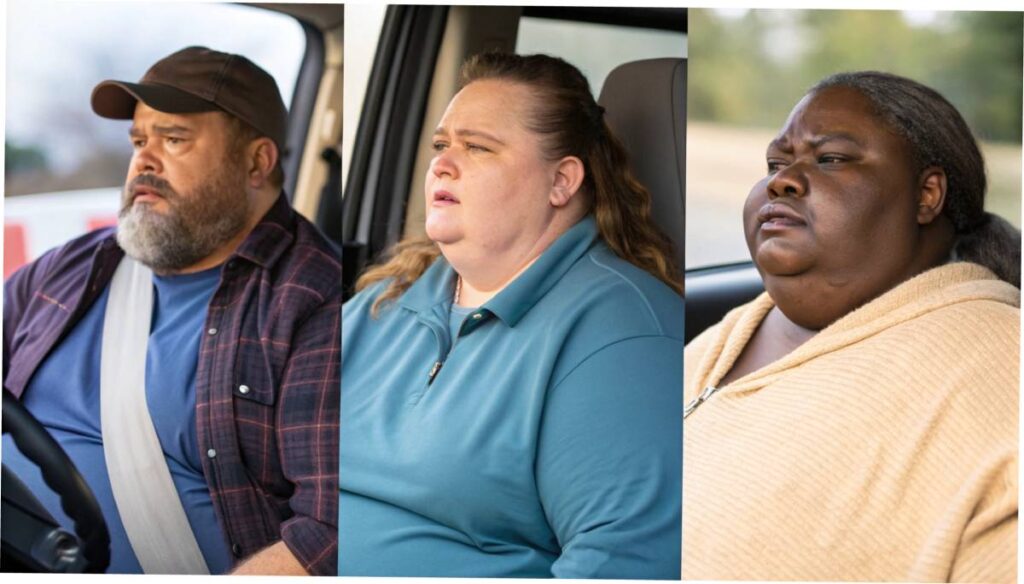
People Over 40 with Sleep Issues
Getting older can sort of mess with your z’s. Once you hit 40, your body might throw some curves, affecting how well you sleep, including possibly inviting sleep apnea over. As you age, muscles lose their tone, hormones shuffle around, and sleep patterns can get all whacky.
| Age Group | Risk Level |
|---|---|
| Under 30 | Low risk, sleep tight |
| 30 to 39 | Moderate risk, caution advised |
| 40 and older | High risk, stay alert |
Those in the 40-and-up club might see sleep apnea crank things up a notch. If you’re often feeling dead tired during the day or your snoring could rival a chainsaw, you might want to get things checked out. For the full lowdown on this, head to our article about what causes sleep apnea.
Spotting those at higher risk can give everyone a wake-up call to pay more attention to their sleep habits. And if you’re a partner of a snorer or can’t stand the idea of CPAP therapy, knowing these risk factors is pretty key.
Specific Risk Factors
Some folks might be more likely to develop sleep apnea thanks to where life has led them or who they share a pillow with. Let’s look at two groups: those who snuggle up with a heavy snorer and the road warriors—commercial drivers needing that all-important DOT certification.
Partners of Heavy Snorers
Shacking up with a loud snorer? It’s like living with a chainsaw—noisy and not exactly rest-inducing. All this racket can throw off sleep and might point to sleep apnea in Mr. or Mrs. Snore-a-lot. This nocturnal noise means restless nights and fighting off yawns in the daylight. You and your partner might both find yourselves up and down like a seesaw, desperate for a solid night’s rest.
| How Snoring Affects Partners | What Happens |
|---|---|
| Broken Sleep | You’re grumpy and dragging all day |
| Stressing Out | Worrying about the snorer’s health woes |
| Love Life Woes | Less “us time” and more earplugs |
Big tip here: if your sleeping beauty sounds like a freight train, it’s time for a chat about seeing a doc. Early intervention could sort out the snorer’s sleep problems—and stop you from reaching for those earmuffs. Curious to know more? Check out what causes sleep apnea.
Commercial Drivers Needing DOT Certification
Here’s the deal for commercial drivers: nodding off on the job is a big no-no. But when sleep apnea slips in, it brings on groggy days that muck up safe driving. The Department of Transportation (DOT) might just put you through a sleep apnea screening if you show symptoms during a check-up.
| Sleep Apnea’s Effect on Drivers | Results |
|---|---|
| Higher Crash Risk | Slower reactions, drowsy days |
| Job Security Issues | Might lose gigs or certs |
| Long-term Health Hits | Trouble for your ticker and more |
For drivers, recognizing sleep hiccups is a must-do. A sleep apnea check can keep their health and those driving papers in good shape. Also, diving into central vs obstructive sleep apnea could give them a handle on what’s going on and how to fix it.
By cluing into these risk factors, folks can nab the help they need, making way for healthier days and nights for everyone involved.
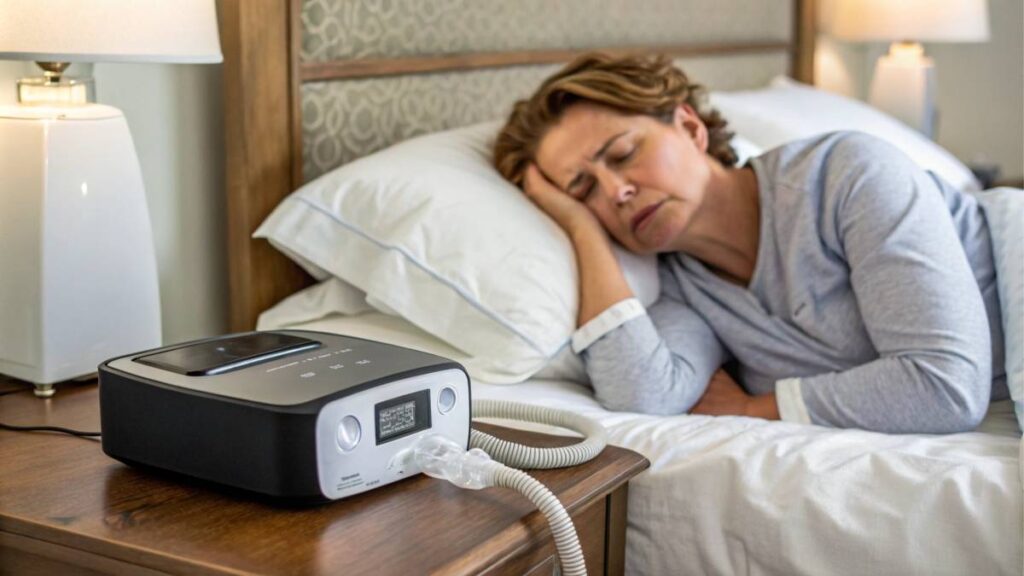
Challenges and Considerations
Individuals Resistant to CPAP Therapy
Some folks just can’t get on board with the whole Continuous Positive Airway Pressure (CPAP) routine. Whether it’s the snug-as-a-bug mask, the whirring alien machine at your bedside, or that shut-in feeling that gets under their skin, they find it hard to stick with it. Trying out CPAP can have its ups and downs for everybody, and it might not always cut it in keeping your zzz’s uninterrupted.
For those shaking their heads at CPAP, there’s hope! Take a look at alternatives to CPAP that might just be a better fit. We’re talkin’ oral gadgets, sleeping tips, and lifestyle hacks to get you dreaming sweetly sans machine.
Parents Concerned About Pediatric Sleep Apnea
Worries about sleep apnea are not just for the grown-ups; kiddos get it too. Parents might pick up on signs like their kid sawing logs loudly, having stop-and-go breathing, or being sleepier than a cat in a sunbeam all day. It’s normal to be concerned about pediatric sleep apnea, and catching it early can be a game-changer for your little one’s health and development.
Kiddo apnea looks a little different than in grown-ups, so it’s key for parents to clue into pediatric sleep apnea symptoms. Catching this early on with a home sleep apnea test could make all the difference and keep those worries at bay.
Post-Menopausal Women
Ladies in their post-menopausal years might find themselves snoozing alongside sleep apnea thanks to those pesky hormone upheavals that sometimes shake up the tone of their throat muscles. This new chapter could turn up the volume on apnea symptoms, so keeping an eye on these changes is a must.
Some studies show that sleep apnea in post-menopausal women can look a bit different than it does for men. Knowing the ropes about these risks and symptoms means women can get the right help they need. And if there’s a curiosity about how slimming down might ease sleep apnea, mosey on over to does weight loss help sleep apnea to score some pointers on making sleep smoother.
Knowing the ropes about the hurdles and handy fixes tied to sleep apnea is a smart move for everyone in the mix, from those steering clear of CPAP to parents keeping an eye on their kids’ nighttime habits.
Main Tips
- Monitor Your Sleep Patterns: Keep track of your sleep quality and any irregularities, such as snoring or breathing pauses.
- Maintain a Healthy Weight: Reducing excess weight can significantly lower the risk of developing sleep apnea.
- Sleep on Your Side: Positional therapy can help keep airways open and reduce sleep apnea symptoms.
- Limit Alcohol and Sedatives: These can relax throat muscles, worsening sleep apnea.
- Consult a Sleep Specialist: Early diagnosis and treatment are crucial for managing sleep apnea effectively.
Final Thoughts
Sleep apnea is more than just a nighttime nuisance; it’s a significant health concern that can profoundly impact your life if left unaddressed. By recognizing the key symptoms—such as loud snoring, breathing interruptions, and persistent daytime fatigue—you empower yourself to seek timely intervention and improve your overall well-being. Understanding who is at higher risk and the potential health complications underscores the importance of proactive management. While treatments like CPAP therapy are effective, exploring alternative solutions and making lifestyle adjustments can also play a vital role in mitigating the effects of sleep apnea. Remember, quality sleep is foundational to a healthy, energized life. Don’t hesitate to consult healthcare professionals if you suspect sleep apnea; taking action today can lead to restful nights and brighter days ahead.
Conclusion
Unmasking the signs of sleep apnea is more than just identifying disruptive snoring or random breathlessness during the night. It’s about understanding the profound ripple effects this condition can have on your overall health, mental well-being, and daily safety. From the increased risk of heart disease and mental health challenges to the dangers of daytime drowsiness impacting your professional and personal life, sleep apnea is a silent adversary that demands attention. Recognizing the common symptoms—like persistent snoring, breathing pauses, and excessive sleepiness—can be your first step toward reclaiming restful nights and vibrant days. Additionally, being aware of high-risk groups, such as individuals who are overweight or over 40, can prompt timely interventions. While challenges like resistance to CPAP therapy exist, exploring alternative treatments and lifestyle changes can make a significant difference. Ultimately, prioritizing your sleep health not only enhances your quality of life but also safeguards your long-term well-being. Don’t let sleep apnea steal your nights and jeopardize your days; take proactive measures today for a healthier, more energized tomorrow.
FAQs
What are the primary symptoms of sleep apnea?
The primary symptoms include loud and persistent snoring, pauses in breathing during sleep, and excessive daytime sleepiness. Other signs may involve morning headaches, difficulty concentrating, and mood changes.
How does sleep apnea affect heart health?
Untreated sleep apnea can lead to high blood pressure, heart disease, and an increased risk of stroke. The repeated interruptions in breathing strain the cardiovascular system over time.
Who is at higher risk for developing sleep apnea?
Individuals who are overweight or obese, those over the age of 40, partners of heavy snorers, and commercial drivers needing DOT certification are at higher risk for sleep apnea.
What are the alternatives to CPAP therapy?
Alternatives to CPAP therapy include oral appliances, lifestyle changes such as weight loss and exercise, positional therapy, and in some cases, surgical options to keep airways open.
Can children develop sleep apnea?
Yes, children can develop sleep apnea, often presenting symptoms like loud snoring, pauses in breathing, restless sleep, and daytime behavioral issues. Early detection is crucial for effective management.

